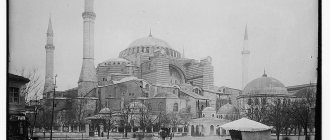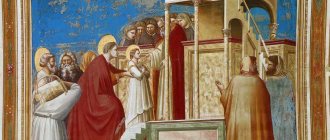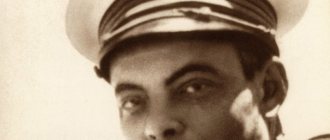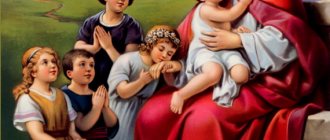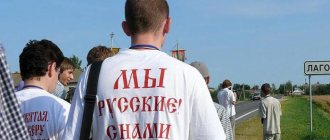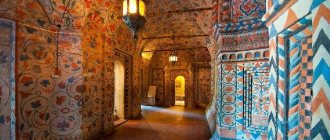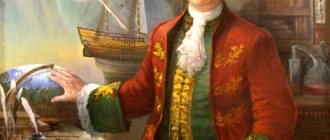Victor Yushkovsky Culture October 23, 2019
It is no coincidence that mosaics, familiar to ancient Russian masters, were revived in the 19th century on the banks of the Neva. For the damp St. Petersburg climate, “eternal painting,” as it was called, was perfectly suited. Moreover, many architectural monuments of the northern capital, including the Church of the Savior on Spilled Blood, were endowed with this exquisite decoration by the famous Frolovs’ workshop. The great-grandson of its founder, Vladimir FROLOV, a specialist in the field of mosaics, an employee of the Russian Institute of Art History, believes that today such a craft is becoming increasingly in demand. In a conversation with SPb Vedomosti correspondent Viktor YUSHKOVSKY, he spoke about the features of this type of monumental and decorative art and the prominent representatives of his “mosaic” dynasty.
Mosaic on the facade of house No. 28 on Bolshaya Zelenina Street. PHOTO by Alexander DROZDOV
Byzantine virtuosi
— Vladimir Alexandrovich, wasn’t mosaic art originally Russian?
— Mosaics, which appeared in Rus' after the adoption of Christianity, were used in the design of St. Sophia Cathedral and other churches in ancient Kyiv. It became widespread thanks to craftsmen invited from Byzantium. But, adopting their experience, Russian masters left masterpieces that were not inferior, or even superior, in artistic value to the creations of the Byzantine virtuosos of this matter.
True, due to various historical reasons, primarily the Tatar-Mongol invasion, the secrets of the skill of Russian craftsmen have sunk into oblivion. As well as the methods of making “pebbles” from which mosaic works were laid out. And when, several centuries later, the great Lomonosov tried to revive this craft, he had to go a long way again, reviving such a beautiful and durable material from scratch using his own recipe.
- Why was he interested in him?
“In the mosaic art objects that Chancellor Mikhail Vorontsov brought from Italy, he saw a combination of elements of science and art. This is what attracted the scientist, who was interested in chemistry. Knowing that the Italians kept the production of smalt a secret, and the methods for producing musia, as it was called in Rus', were lost, he began to conduct experiments. And after thousands of experiments, he managed to create a whole palette of such “stone paints”.
Lomonosov mosaics, stored in the State Hermitage and other museum collections, were executed at a high artistic level: portraits of Alexander
Nevsky, Empress Elizaveta Petrovna, etc. And the mosaic canvas “Battle of Poltava,” his most monumental work, designed to decorate the tomb of Peter the Great in the Peter and Paul Cathedral (this plan was not realized), was later moved to the wall of the main staircase of the Academy of Sciences in Leningrad.
Chronology of events
During its history, St. Sophia Cathedral has endured many trials. It was repeatedly destroyed and rebuilt, almost completely rebuilt. In 1240, the temple underwent serious changes for the first time, it was then that the Mongol-Tatars attacked Kyiv. Sophia of Kiev (photos of the cathedral are presented in the article) was plundered and almost completely destroyed. The splendor and riot of colors faded for some time.
The complete restoration of the monument to Sophia of Kiev took place under Metropolitan Peter Mogila, who founded a monastery at the temple. The cathedral had the same appearance, but the building itself required immediate reconstruction. In 1633-1647 the temple was partially restored. We repaired, replaced the roof, floors and installed a luxuriously decorated iconostasis in the Cathedral of St. Sophia of Kiev. A photo taken inside can only convey a small part of all the beauty.
The year 1697 became fatal for the cathedral. The fire consumed almost all the wooden buildings of the monastery. After this, a decision was made to undertake a major restoration. At that time, the three-tier Sofia Bell Tower was erected. In 1852, the fourth tier was completed. The cathedral building itself was also rebuilt, and it acquired the Ukrainian Baroque features characteristic of that time.
In 1722-1730, a refectory and a bakery were built on the territory of the monastery, which later housed the diocesan administration.
In 1934, by decision of the Soviet government, the temple buildings were declared a State Reserve of History and Architecture.
The Soviet period breathed new life into the development of the monastery. It was at this time that restoration work was actively carried out, as a result of which the appearance of the temple and other buildings of the complex were restored.
In 1990, Sophia of Kiev was included by UNESCO in the List of World Cultural Buildings. In the same year, the cathedral was awarded a charter, which gave the right to independent governance.
A unique architectural monument is Sophia of Kyiv. The description and history of its creation excites the imagination of even people far from religion.
Miracle Worker made of smalt
— Who continued the work of Mikhailo Vasilyevich?
“Unfortunately, Lomonosov’s experiments were not continued, and his discoveries in this area did not actually reach his descendants. Mosaic work was revived in our country later, when, when creating the interior decoration of St. Isaac's Cathedral, which grew near the Neva, the question arose: how to extend the life of painted icons, the colors of which were crumbling from dampness?
It was then, on the initiative of Montferrand, who created the most majestic temple in Russia, several graduates of the Imperial Academy of Arts (IAH) went to Rome, where in 1847 the Russian Studio was created at the Vatican mosaic workshop. Vasily Raev, Egor Solntsev, Semyon Fedorov and others studied there.
— They became the first Russian mosaic artists of the 19th century?
— Not exactly, their predecessor was Georg Weckler, who made a mosaic copy of Salvator Rosa’s painting “The Prodigal Son,” which was acquired by Empress Elizabeth I. Under Alexander I, he received the title of academician, having completed several miniatures for him, which are stored in the Hermitage. His student Alexander Sivers worked in the same technique, creating mosaic images of the Savior and St. Nicholas the Wonderworker. But both were widely known, as they say, in narrow circles.
Having mastered the mosaic technique, the students of the Russian Studio returned home, and in 1851 a mosaic department was opened at the Imperial Academy of Arts. At the same time, the Italian brothers Bonefede arrived in St. Petersburg at the invitation of the Russian authorities to establish the production of smalt. The eldest of them, Giustiniano, supervised these works (they were carried out at a glass factory located near the Obvodny Canal and later became part of the Imperial Porcelain Factory), and the youngest, Leopold, who had great knowledge of chemistry, helped him...
Baptistery
In addition to the buildings described above, there are two baptisteries in Ravenna - Arian (Battistero degli Ariani) and Orthodox (Battistero degli Ortodossi, or Neoniano).
Inside these buildings, intended for the sacrament of baptism, you can also find amazingly beautiful mosaic paintings. Both were recruited at approximately the same time - the second half of the 5th - beginning of the 6th centuries. The iconography of the images is simple: in the vaults of both buildings there is a scene of the Baptism of Christ, around which there are figures of the twelve apostles.
The difference is noticeable in the details. For example, the apostles in the Orthodox baptistery have their names signed, but the same disciples in the Arian baptistery have no names.
Therefore, they are difficult to identify. They seem to have some characteristic features, but we remember that a strict canon for depicting saints did not exist then. This gives freedom of interpretation. Only Peter and Paul are recognizable, since their obligatory attributes are visible in their hands: the first has the keys to Paradise, the second has a scroll.
Another important difference is the difference between the truly Christian and Arian faiths, which is reflected in the mosaic images. Christians understand the baptism of Christ as the union of God the Father, God the Son and the Holy Spirit.
Arians are sure that until the moment of baptism Jesus was a simple man, and only in this sacrament acquired his divine essence. Therefore, in the Arian Baptistery, water pours from the beak of a dove onto the mosaic Christ, a symbol of Jesus receiving a new nature.
The wonderful thing about the sights of Ravenna is that when looking at the buildings from the outside, it is impossible to imagine what mosaic beauty awaits inside. The façade of the buildings does not correspond in any way to the interior. So, for a portion of admiration, delight and surprise, it is better to go here.
Thousand shades of Isaac
— Why did smalt turn out to be the most convenient material?
— This is durable colored glass, melted using a special technology with the addition of oxides of various metals (copper, tin, iron, manganese, etc.). Quartz sand (it served as the starting material), previously purified from impurities, has long been mined in the vicinity of St. Petersburg, and there was no shortage of it. And the properties of the resulting material depended on the additives that gave it the desired color, the chemical composition of the glass melt and the firing regime.
Related article:
Banner with pretzels. How St. Petersburg artisans came up with distinctive signs for themselves
Thus, to work on the artistic decoration of St. Isaac's Cathedral, where the finest halftones were conveyed, mosaicists used more than 12 thousand shades of smalt. Its colors did not fade, it did not crack and “resisted” dampness: this material could last for centuries. Moreover, the old smalt, having a rich color, did not have shine, unlike the modern one, that is, it looked little like “pieces of glass.” It was this (as well as ceramics coated with thin enamel) that the Bonefede brothers produced for decoration needs.
Smalt was formed into rectangular tiles, which were split into small square and rectangular pieces. In the workshop at the Imperial Academy of Arts, the Roman (direct) method of mosaic typing was practiced: a metal “frying pan” (frame) was filled with temporary mastic, the contours of the image were applied, and then “painted” with smalt, achieving stunning realism. The pebbles were placed tightly, choosing them according to size and color, then the seams were tinted with wax paints and polished.
It was believed that only a certified artist could perform such work, accurately repeating the original. In fact, it was not a copy, but an independent work that required high talent; such work was expensive and time-consuming. The smalt “paintings” of St. Isaac’s Cathedral, created over more than half a century (62 mosaics with a total area of over 500 square meters), received gold medals at exhibitions in London and Paris (in the 1860s) and European recognition...
— Did your great-grandfather participate in their creation?
— Yes, Alexander Nikitich Frolov, one of the first in Russia to be awarded the title of academic mosaic artist, made smalt icons for this and other cathedrals, and one of his works received a medal at the World Exhibition in Vienna. Under his leadership, mosaic ornaments were also installed in the Moscow Cathedral of Christ the Savior. For many years he headed the mosaic department of the Imperial Academy of Arts, for which a separate building was built (3rd line of V.O., building 2a), and in 1890 he and his son founded the first Russian private workshop of this kind and became its director.
Stages of creation
Modern mosaics in the temple practically replace wall paintings. In the main St. Petersburg Orthodox church - St. Isaac's Cathedral - the mosaic covers 592 square meters. m. The artists were able to convey the shine of cold metal, the shimmer of satin clothes, the warmth and softness of human skin. More than 12 thousand colors and shades are used here.
In May 2021, construction of the Main Cathedral of the Armed Forces of the Russian Federation was completed in Moscow. The area of the mosaic in the temple is 2644 square meters. m. - according to the number of full holders of the Order of Glory. Photographs of the new cathedral convey the luxury and multicolored temple mosaic decor.
Artistic idea
Creating a mosaic in a temple is a difficult and painstaking process. Mosaic masters say that installation work takes only 20% of the time, the remaining 80% is developing a sketch and preparing pieces of smalt.
The idea of temple mosaic decoration from ancient times to the present day carries with it the glorification of the beauty and grace of God's world. An abstract idea is embodied in a concrete composition, an image of a holiday or a saint.
To obtain an expressive, picturesque work, the muralist takes into account the smallest details: stone chips, surface relief, the size of the seams between the pieces.
Mirror pictures
— What prompted your great-grandfather to take this step?
— His eldest son Alexander worked in the department as a technician. Transferring the mosaic set from temporary mastic to a permanent base (cement), he thought about reducing the cost of such a process. The Italian Antonio Salviati at that time was already using the Venetian (reverse) typesetting method. A young Petersburger was assigned to him, who, learning this method, studied ancient and Byzantine mosaics.
With this technology, smalt was glued onto tracing paper, then the set (a mirror image of the future image) was filled with cement, and the film was washed off. Abroad, this method, which made recruitment cheaper and faster, was then widely used. But in the academic environment they treated him with distrust, because not only artists, but also ordinary craftsmen under the supervision of specialists could perform such work.
Returning to Russia, the academician’s son proposed and wanted to introduce his own method of reverse typing, in which a mosaic was created “adapted” to the St. Petersburg climate. But few of the members of the IAH supported him, and then, using the authority of his father, already in a new workshop located on Kadetskaya Line, 13 (the house was rebuilt), he began to put this method into practice.
- Where exactly?
— The “handwriting” of the Frolov workshop can be seen on the facades of the buildings where the Society for the Encouragement of Arts (Bolshaya Morskaya Street, 38) and the Mutual Credit Society (Griboyedov Canal Embankment, 13) were located. Her monumental mosaic icons decorated the Church of the Epiphany on Gutuevsky Island.
The workshop also carried out orders in various Russian provinces. But her most significant creative legacy is associated with the mosaic “painting” of the Savior on Spilled Blood. The Frolov mosaic was not inferior to others in its artistic merits, but was stronger, cheaper and easier to manufacture, and in 1895 it won a competition to create the external and then internal decoration of the temple.
Early Christian art
Early Christian art is usually called religious motifs in culture from the birth of Christianity until the formation of Byzantine art in the 6th-7th centuries.
The church's attitude towards this has always been complex and contradictory. The trends of Judaism suggested that art is a pagan medium, God is intangible and cannot be depicted. On the other hand, the traditions of Hellenistic culture had not yet completely died out and demonstrated that material objects are capable of performing a moral and educational function and symbolizing spiritual entities. In addition, Jesus appeared in the form of a man, so he could be depicted. The same is true for martyrs. That is why biblical paintings are such a popular theme among inspired artists.
The first religious subjects can be seen in the painting of catacombs, sarcophagi, and newly built basilicas. They concentrated on icons, frescoes and mosaics.
Duke, Pel and Lenin
— It was probably difficult to carry out work of such volumes without developing new technology?
— The technology has appeared. At the construction site, they put together a wooden workshop and installed a furnace to smelt smalt right on the spot. But in the midst of these works, Alexander died (peritonitis after surgery), and his younger brother, my grandfather Vladimir Alexandrovich, who also studied at the Imperial Academy of Arts, was forced to take charge of the workshop, because his father was already in his old age.
Under the leadership of the Frolovs, a school of decorative mosaic was formed. Young students who did not have an artistic education became excellent masters, performing complex compositions based on the sketches of 32 artists (including Vasnetsov, Nesterov, Ryabushkin, etc.). Such sketches, made in different manners, were held together by a common typesetting method, and most of them met the requirements of monumental and decorative art, so the result was a harmonious ensemble.
— The mosaics of this workshop were preserved not only there?
— Her “autograph”, the combined letters “M” and “F” (Frolovs’ workshop), was left on the former apartment building of the Duke of Lichtenberg (Bolshaya Zelenina Street, 28), which is decorated with large mosaic panels.
Other St. Petersburg addresses: house (Nevsky Prospekt, 28), Nabokov Museum (Bolshaya Morskaya Street, 47), Doctor Pel's pharmacy (7th line V.O., building 16 - 18). Inscriptions and design elements made of smalt have been preserved there, and on the wall of the Chamber of Weights and Measures there is a “Frolov” mosaic table of Mendeleev. Moscow addresses: Upper shopping arcades, the current GUM (one of the first works in this city), a number of metro stations, in the design of which my grandfather participated, etc.
When creating the Lenin Mausoleum, architect Alexey Shchusev invited him to create mosaics (stylized banners made of purple smalt), essentially rehabilitating this art, which was considered “religious” and began to fade away during the Soviet years. However, this did not save my grandfather from repression: as the former owner of the workshop (although not only for this reason), he was arrested three times. My grandmother, the daughter of the architect Leonty Benois, also went to prison. And my father did not escape the same fate in his youth.
Stained glass
The name "stained glass" in French means window glass. According to history, the first stained glass windows adorned the churches of the Catholic Church back in the first century AD. Due to the use of colored glass, the light passing through the stained glass window is colored and creates an atmosphere that is optimal for places of worship.
The oldest works in Europe are considered to be five fragments of stained glass windows from the Augsburg Cathedral. They are made of bright multi-colored glass using tonal shading and painting techniques, which only the highest skilled craftsmen could do.
Precious patterns
— How did your father’s fate turn out?
— Having survived the blockade in Leningrad, he became an engineer and worked for. And my grandfather, who did not leave the workshop of the Academy of Arts (he received the title of professor based on the totality of his work), died in February 1942. He managed to send mosaic patterns made for the Novokuznetskaya station of the Moscow metro through Ladoga. Through his efforts, I would add, the mosaics that were destroyed in the 1930s were preserved. Ancient Kiev Church of the Archangel Michael.
Well, the first Leningrad stations were “dressed” with mosaics, including Florentine ones, using semi-precious and precious stones, by his students. Many works of art made in the same way are now kept in the Hermitage. At one time, some items from my grandfather’s collection ended up there, although most of it was not preserved. It’s a pity, it seems to me that such a museum should appear in St. Petersburg: within the walls of the mosaic department of the Academy of Arts or on Bolshoy Prospekt V.O., 64, where the Frolovs’ workshop was also located...
“But this art is not a thing of the past. What are his prospects?
— I won’t say that I’m delighted with all the mosaic works. And the process of smalt smelting has been simplified - the commercial approach often takes precedence. In my opinion, there are fewer shades of it, and it is no longer as durable. But I think the traditions of the St. Petersburg mosaic school have been preserved, and they are manifested in the best modern works. Today's masters experiment no less successfully than their predecessors, mixing styles and using new materials, which is reflected in the design of metro stations...
#mosaic #craft #decor
The material was published in the newspaper “St. Petersburg Vedomosti” No. 199 (6552) dated October 23, 2019 under the heading “Eternal “handwriting” on the wall.”
Share on VKontakte Facebook
Cool
Archbishop's Chapel
In the former residence of the bishops of Ravenna, which today is a museum, there is a small house church. This is the Archbishop's Chapel (Cappella Arcivescovile di Sant'Andrea), consecrated in honor of the Apostle Andrew. It was created at the turn of the 5th-6th centuries.
What’s interesting is that not all the decoration here is mosaic; there is also a lunette painted (but much later) with tempera paint on the plot of the Lord’s removal from the Cross.
The iconography of the chapel is quite simple. In the altar apse, a shining cross is placed against the dark blue starry sky. The arches are decorated with images of the Savior and saints enclosed in round medallions. In the central vault, four angels hold a blue sphere with a monogram (also called “chrisma”) of the name of Christ - these are the first two letters of the name of the Lord. Between the angels the evangelists are depicted in their symbolic appearance.
The mosaic above the entrance door of the chapel may cause confusion. This is a rarely seen image of Christ the warrior. It was formed under the influence of already existing canons of depicting Roman emperors.
Jesus is dressed in armor, with a blue cloak over his shoulder, pinned with a precious pin; in the right hand there is a cross, in the left there is a book open with the inscription “Ego sum via, veritaset, vita”. The phrase can be translated as “I am the way, the truth, the life.” The Lord tramples underfoot the symbols of evil - the lion and the adder. Yes, the lion is a universal character who can personify both light and dark forces. No such problems arise with the asp: this is the same serpent that tempted Eve with an apple from the tree of knowledge. It has no other meanings.
Mandatory elements of any (both mosaic and pictorial) decoration of a Christian church are floral ornaments, patterns, birds and flowers. These are all symbols of the Garden of Eden. In the case of the Archbishop's Chapel, numerous lilies can be found on the vault directly above the entrance.
Section materials
09 December, 13:20
The II Forum of Craftsmen took place in the Leningrad region
October 14, 11:49
Karelian artisans will be taught entrepreneurship skills
August 18, 12:47
Metrostroy terminates contracts with mosaic suppliers
05 February, 11:43
The economics of willow twig. How an ancient craft was revived in St. Petersburg and the Leningrad region
January 21, 07:30
Hall of Fame. How a monument to the periodic table appeared in St. Petersburg
Table of contents
Introduction
…………………………………………………………………………3
- History of mosaic
……………………………………………………………….3
1.1 Methods of mosaic work………………………………………………………5
1.2 Mosaic of ancient Russian churches…………………………………………….7
1.3Technique of Old Russian mosaic floors…………………………………….8
1.4 Mosaic ensembles of Sofia of Kyiv and Sofia of Novgorod……………8
Conclusion
…………………………………………………………………….10
List of used literature
……………………………………….11
Mosaic "Maria Oranta"
The vault of the main altar is decorated with a huge mosaic of the Mother of God (Oranta) in a state of prayer. This image stands out from the entire interior painting. Its height is about 6 meters. The Mother of God stands on a platform decorated with precious stones with her arms raised high. She is dressed in a blue chiton and covered with a long woman's veil with golden folds. Wearing red boots.
This figure is distinguished by its monumentality and special grandeur. Rich colors immediately catch the eye. Under this image there is a mosaic “Eucharist”, symbolizing the scene of the communion of the apostles. Near the throne stand archangels with fans. Also nearby is a figure of Jesus Christ. He distributes communion in the form of bread and wine to the apostles, who solemnly approach him from different sides. The apostles are dressed in light suits, Jesus is wearing a blue cloak and a purple tunic decorated with gold. The crimson throne gives a special color saturation to the composition. The lower tier of the vault is decorated with images of saints and archdeacons.
